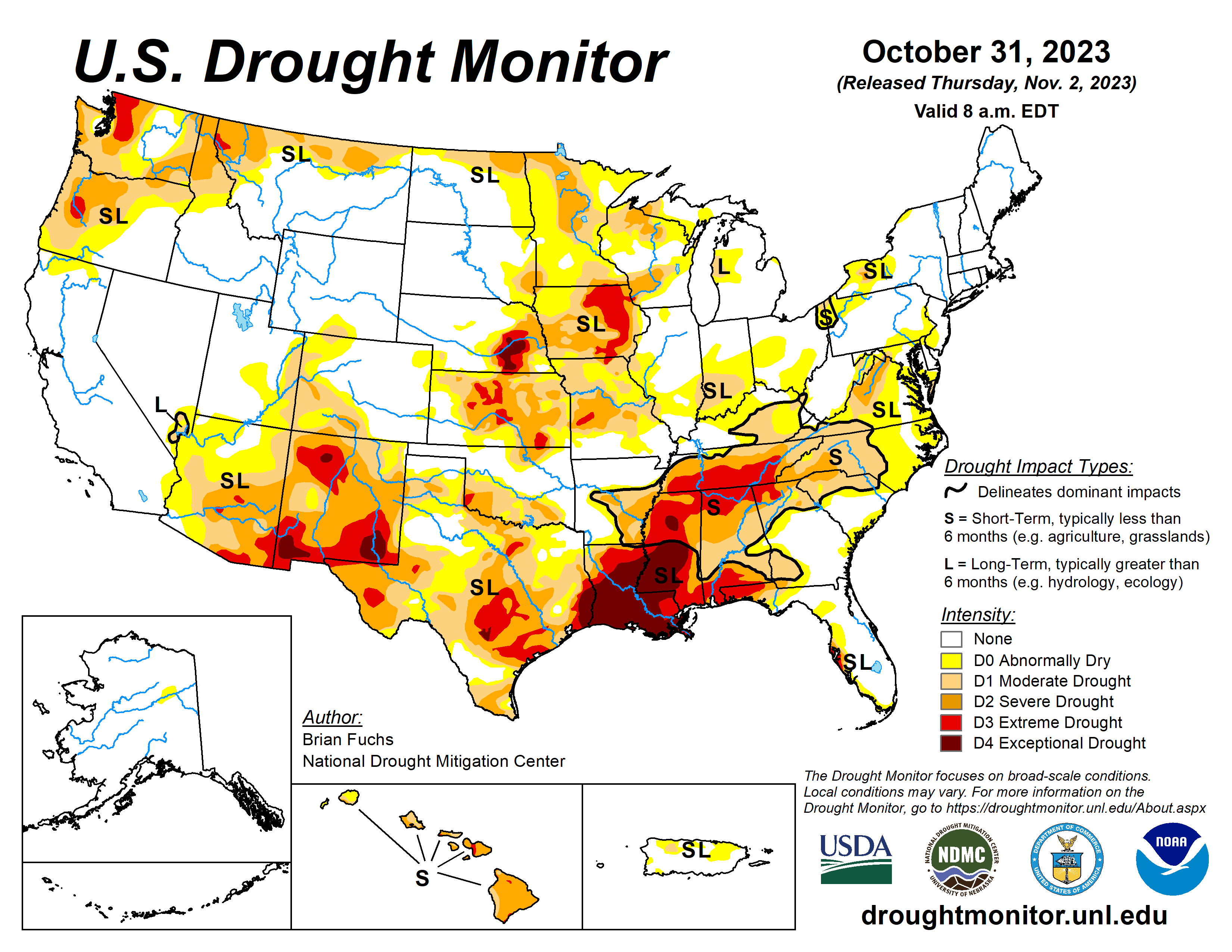One of the first significant storm systems of the season impacted the Plains and into the Midwest. Not only did the region see widespread precipitation, but the first real cold air also dropped in from Canada.
Snow was widespread through the northern Plains and significant rain fell across portions of Kansas, Missouri, Oklahoma, Texas and Arkansas as well as in Wisconsin. The Southeast continued to be dry and warmer than normal while cold air dominated portions of Montana into Wyoming during the past week.
South
Temperatures were mixed for the week as areas impacted by the strong storm system through the region were 1 to 3 degrees Fahrenheit below normal while those farther to the west were 9 to 12 degrees above normal for the week. Significant rain fell over most of Oklahoma and Texas and into northern Arkansas this week, allowing for improved drought conditions. Lake Waco, in north central Texas, gained 112,000 acre-feet, taking it from its historic low of 54.5% of conservation storage to 114% of conservation storage.
Most of these areas had a full category of improvement to their drought status, with some areas of Texas seeing multiple category improvements to the drought intensity. A full category of improvement was made over much of Arkansas this week with a reduction of moderate and severe drought conditions.
Midwest
Temperatures were well above normal over most of the region with eastern portions of the region 9 to 12 degrees above normal. Western areas were near normal but parts of northern Minnesota were 3 to 6 degrees below normal after cold Canadian air impacted the area.
Much of the region received precipitation during the week with only portions of eastern Kentucky and southwest Iowa missing out. Areas of Wisconsin recorded the most rain with some areas at 800% of normal.
Significant amounts of rain were also recorded in western Missouri. With the significant precipitation of the last week and the generally wetter pattern lately, improvements were made over much of the region.
Most of southeast and central Missouri had drought conditions improved this week and northwest Iowa also had moderate drought improvements. Moderate drought was expanded over southwest Iowa, and eastern Iowa saw minimal changes as the long-term drought signal is still significant in this region. Portions of central Wisconsin recorded up to 800% of normal precipitation for the week, removing extreme drought from the state and reducing severe drought too.
High Plains
Significant precipitation was recorded in North Dakota, northeast Nebraska, and central and southeast Kansas. Some of the precipitation in these regions came as snow and it is anticipated that much of the ensuing melt-off will get moisture into the soils.
Temperatures were cooler than normal over most of the region with the greatest departures over the western Dakotas where temperatures were 10 to 15 degrees below normal. A full category improvement to the drought intensities was made over northern North Dakota, central and western Nebraska, and southeast Kansas. Some expansion of abnormally dry conditions took place over eastern Colorado and western Kansas as well as southern Wyoming.
West
Much of Montana and central to western Colorado saw the most significant precipitation for the week, with good amounts of snow in the higher elevations. Great Falls, Montana, recorded over 8 inches of snow for the week and Havre had 5.7 inches. Crested Butte, Colorado, recorded 13 inches of snow for the week while Steamboat Springs had 4.9 inches.
Temperatures were below normal for almost all of the region with most areas 5 to 10 degrees below normal. Areas of Arizona and New Mexico were near normal to up to 5 degrees above normal. Montana and Wyoming received the coldest air and temperatures for the week were 20 to 25 degrees below normal. The precipitation in Montana allowed for improvement to the drought conditions, mainly in the northern portions of the state.
Some improvements were made in western Colorado while there was some slight expansion to the abnormally dry conditions in Utah. Improvements were also made this week in central Washington as the most recent wetter pattern started showing up in the drought indices and indicators, allowing for improvements on the map.
Looking ahead
Over the next five to seven days, much of the southern half of the U.S. is expected to be dry with little to no precipitation anticipated in areas south of a line from central California to Nebraska and into the Mid-Atlantic.
The Pacific Northwest as well as the northern Plains and Midwest are expected to have the most active weather and precipitation. Temperatures are expected to be warmer than normal over the Southwest, southern Plains and Southeast with departures of 8 to 10 degrees above normal in west Texas and into New Mexico. Cooler-than-normal temperatures are anticipated over the northern Plains and upper Midwest with departures of 5 to 8 degrees below normal.
The six- to 10-day outlooks indicates a warmer-than-normal pattern over the southern U.S. The best chance of below-normal precipitation is over the southern Plains and into Arizona and New Mexico.
The U.S. Drought Monitor, pictured above, is jointly produced by the National Drought Mitigation Center at the University of Nebraska-Lincoln, the U.S. Department of Agriculture and the National Oceanic Atmospheric Administration. (Map courtesy of NDMC.)
Brian Fuchs is with the National Drought Mitigation Center.
Sign up for HPJ Insights
Our weekly newsletter delivers the latest news straight to your inbox including breaking news, our exclusive columns and much more.




